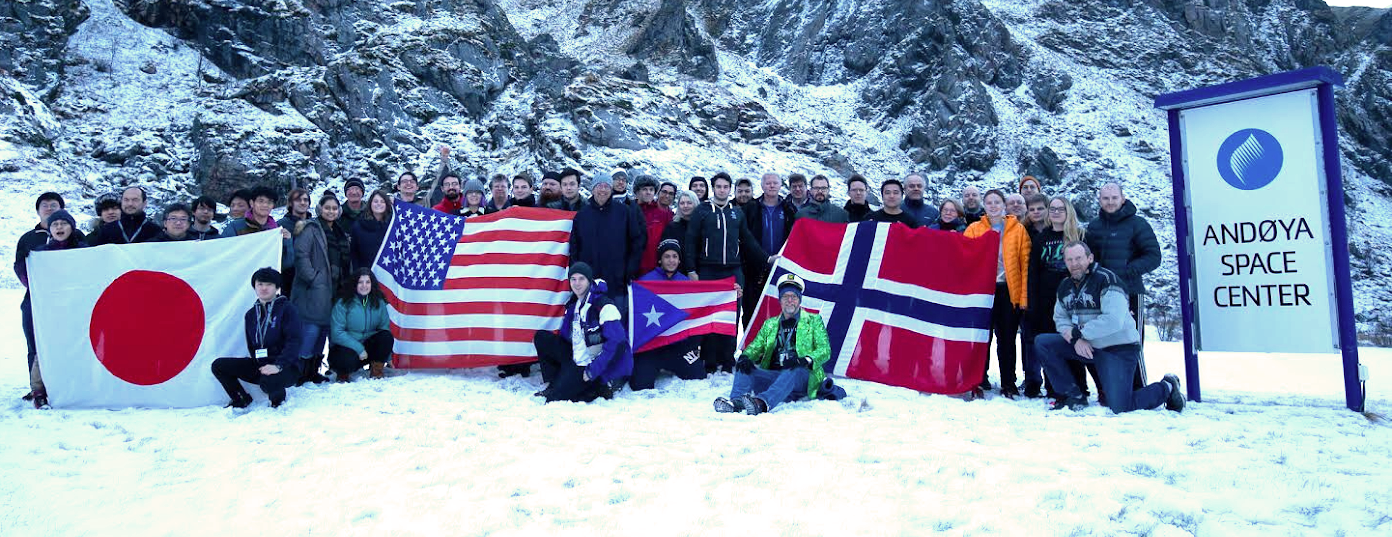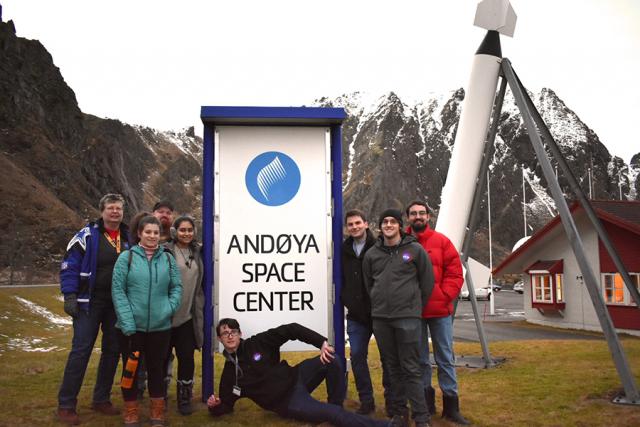Capitol Tech’s Project Aether team launches science payload into space
February 5, 2019Top photo courtesy of Chris Perry, NASA
A student team from Capitol Technology University is back in the United States after its science payload was successfully flown into space aboard a rocket launched out of Andøya, Norway, on January 13.
It was a down-to-the-wire experience for the Project Aether team members, who had traveled to Norway for the culminating moment of an interdisciplinary endeavor spanning close to two years. Wintry weather prevailed during much of their time there, with conditions alternating among rain, sleet, and snow.
On the second to last day before the launch window closed, they received the news they were hoping for: the weather had cleared.
“It was a real nail-biter,” says Sam Lawson, the project’s CAD designer. “But, in the end, the moment we’d been preparing for all these months finally happened.”
Project Aether got its start in 2017 when a group of young astronautical engineers, computer scientists, and business students applied for the RockSat-XN program, established through a partnership between the Wallops Flight Facility and the Andøya Space Center. RockSat-XN provides launch opportunities for student teams as part of the Grand Challenge Initiative, in which seven internationally-sponsored rockets are being launched out of Andøya and Svalbard in order to conduct research on cusp space physics.
The Capitol Tech students secured a berth aboard one of the rockets with an ambitious science payload that included three different science objectives: measuring the effects of the Aurora Borealis on the atmosphere, testing the performance of a new insulation system, and comparing different methods of receiving data from the payload while it was in space.
“Our primary experiment was a spark gap spectrometer, which in essence enabled us to ionize the air, so we could observe the light coming off it and obtain chemical composition data as we flew through the aurora. That way, we can compare the data to the known chemical composition without the aurora,” Lawson explained.
The insulation experiment, meanwhile, compared multi-layer insulation (MLI) – the familiar, gold-toned material that has become the standard for space flight – to a new, aerogel-based method devised by students on another Capitol Tech student project, TrapSat.
The fifteen-minute flight did not bring in as much data about insulation performance as the team would have liked, Lawson said, but a preliminary analysis suggests both methods provided about the same level of insulation.
“It looked like the MLI may have been slightly warmer, but we didn’t see strong enough curves to make a conclusive determination,” Lawson said. “Overall, we can conjecture that their performance was roughly the same. If nothing else, we’ve increased the technology readiness level of our aerogel insulation, and we can move forward with future experiments.”
The third experiment set out to compare data received via the rocket’s telemetry line to data obtained via the Iridium satellite constellation, using a method first developed by the Project Hermes team at Capitol Tech. For unknown reasons, the experiment did not successfully capture the Iridium data.
“While the third experiment failed, we are very happy that we obtained useful data from the first two,” Lawson said.
Capitol Tech was one of only seven schools selected for the international-level Norway program; others included Penn State and the University of New Hampshire. The Capitol team is collaborating with students from UMBC, and the Maryland Space Grant Consortium provided funding for the launch.
In addition to Lawson, the Project Aether team consists of Christopher Murray, Erik Schroen, Pierce Smith, Dean Zinetti, and co-leaders Sophia LoSchiavo and Marissa Jagarnath. Following the successful launch, Lawson and Murray are currently analyzing the results, under the supervision of Dr. Carlos A. Romero-Talamás of UMBC, the project’s principal investigator.
Project Aether is the newest among several Capitol Tech student projects that have made it to space. The earlier Hermes and TrapSat projects have already been launched on sounding rockets as part of NASA’s RockSat-X program. As part of a combined project, CACTUS-1, they are awaiting an orbital flight this year through the CubeSat Launch Initiative.
Projects like Aether provide “great practical experience that students can use in their careers after they graduate,” says the chair of astronautical engineering at Capitol Tech, Angela Walters.
“All of us at Capitol Tech are tremendously proud of the Project Aether team and their achievements,” Walters said. “The project has brought together students from different programs across the university to collaborate on designing a complex science payload. It’s great preparation for their professional careers.”
“Lots of people dream about building something and launching it into space on a rocket. Capitol Tech students get to do it,” she said.




